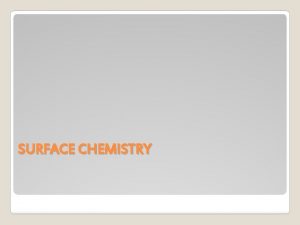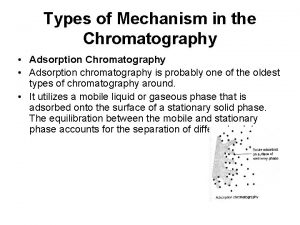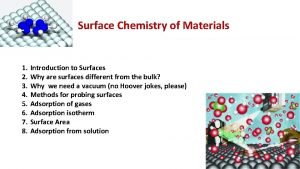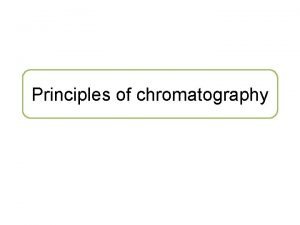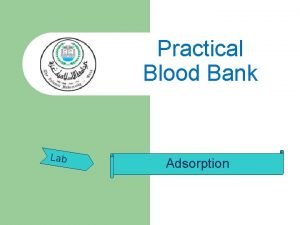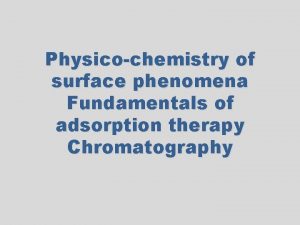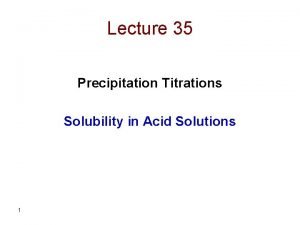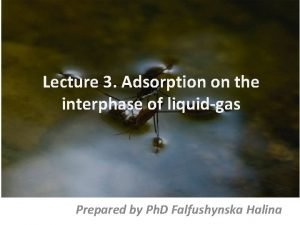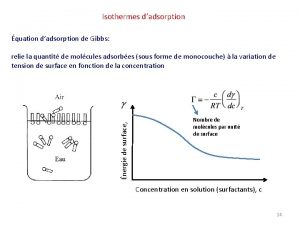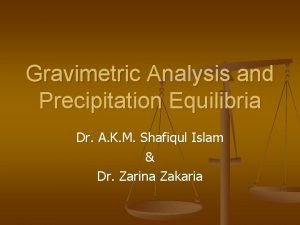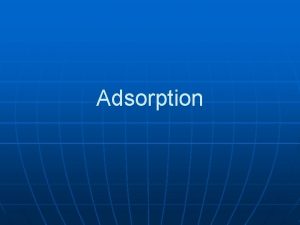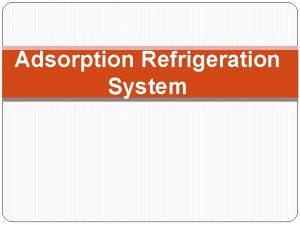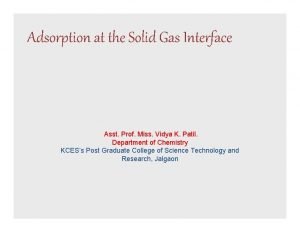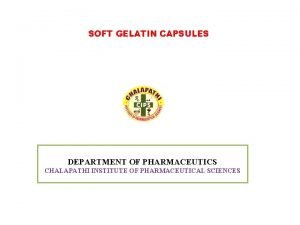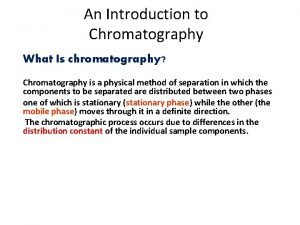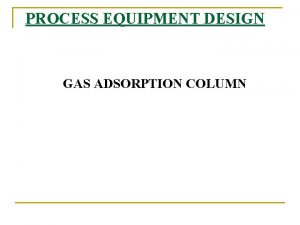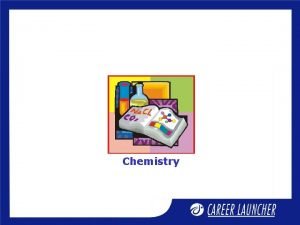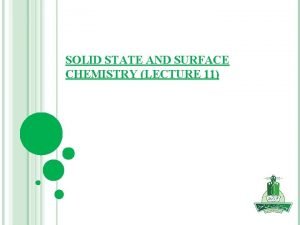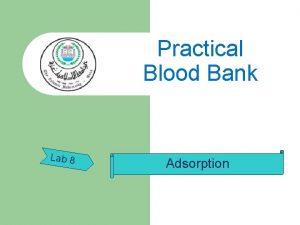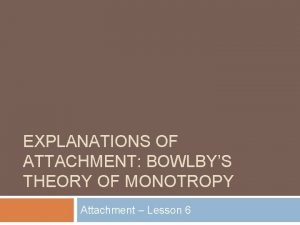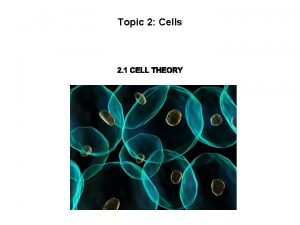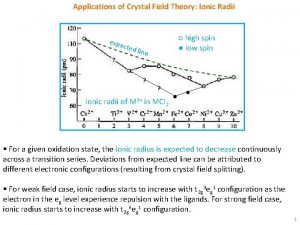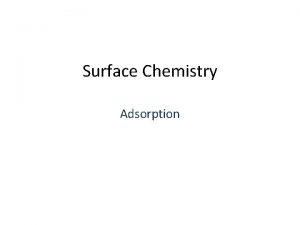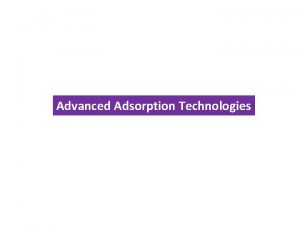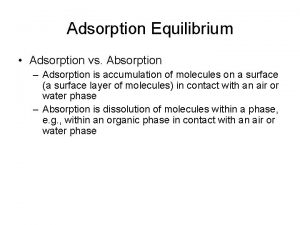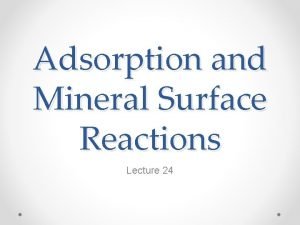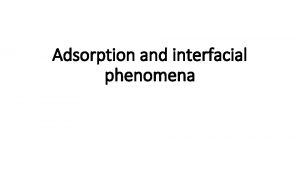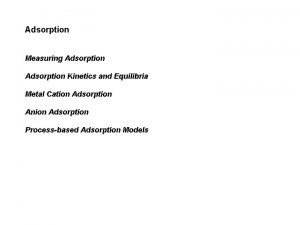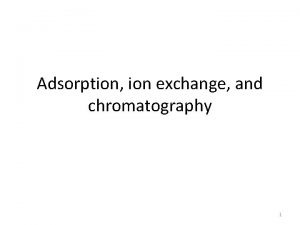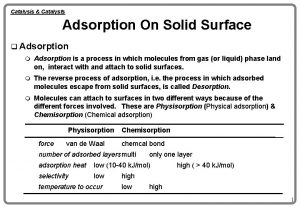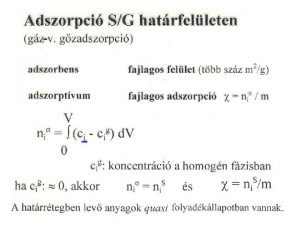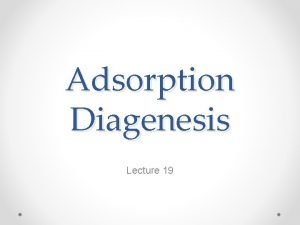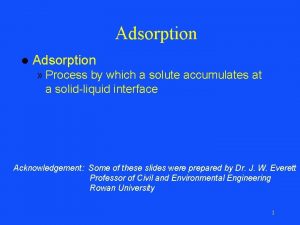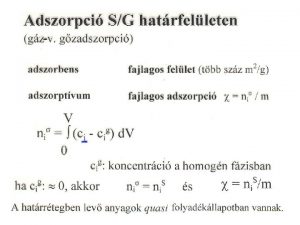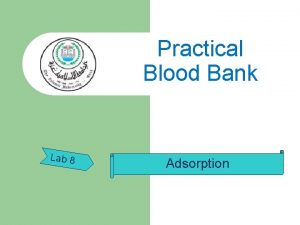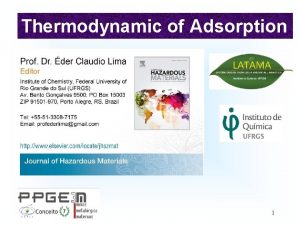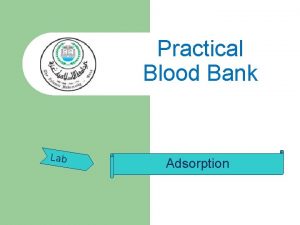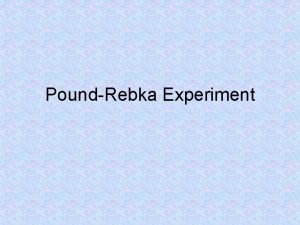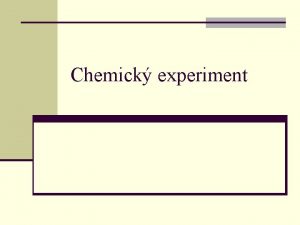N 2 ADSORPTION theory experiment and application OUTLINE





































- Slides: 37

N 2 – ADSORPTION theory, experiment and application OUTLINE: - Short review of theory - Experimental methods and machinery at the lab - Case studies

ADSORPTION adsorbent theory adsorbate adsorptive • some properties of adsorption (physisorpion): exothermic, non-specific, adsorption energy low, not activated, multilayer, no dissociation/electron transfer

ADSORPTION INTERACTIONS theory • Adsorption interactions: • adsorbent and adsorptive are important Examples: Adsorptive Adsorbent Interactions alkane graphitized carbon black ED, ER alkane zeolite ED, ER, Ep water graphitized carbon black ED, ER, Ep zeolite ED, …, EFq N 2

ADSORPTION ISOTHERM theory • amount of N 2 adsorbed versus relative pressure at constant temperature • temperature: 77 K: boiling/condensation point of N 2 at patm=p° • Amount adsorbed per unit adsorbent mass: n Vads, liq Vads, STP … mol/g ml/g = cm 3/g ml/g • STP = 0 °C, 1 bar •

ADSORPTION ISOTHERMS: TYPES • IUPAC classification: theory

EXPERIMENTAL • how is an adsorption isotherm recorded? gas • Total volume of system determined: - “manifold” volume known - sample volume determined with He • System is evacuated • Start of adsorption: - amount of gas dosed in manifold - p measured qty known - gas expanded into sample volume - equilibrium p measured; compared to calcd p - difference amount adsorbed at p • p° measured to account for temp changes in liq. N 2 • Lower p/p° limit: determined by pump and pressure measurement vacuum manifold P sample Liq. N 2

MACHINERY AT COK Micromeritics Tristar • discontinuous method: experimental 2 x Coulter Omnisorp • continuous method: dosing: constant low flow quasi-equilibrium measure pressure amounts of gas dosed wait until equilibration measure pressure • limited amount of points • infinite amount of points • short measurement possible • long measurements • three samples simultaneously • p/p°min: 10 -4 – 10 -3 (“left” omnisorp) • p/p°min: 10 -4 – 10 -3 • p/p° min: 10 -5 – 10 -4 (“right” omnisorp)

SPECIFIC SURFACE AREA theory • 2 frequently used methods: 1. BET 1. Comparative methods: • t-plot or a. S-plot general remark on concept of determination of the specific surface area : - surface roughness – probe molecule size - measured area dependent on size of probe molecule: fractal property

SPECIFIC SURFACE AREA: BET • theory Two steps: 1. Evaluation of the monolayer capacity Vm 2. N 2 cross-sectional area a. N 2: Vm x a. N 2 = S • Not very accurate (20 % error) because: 1. BET model assumptions usually not valid homogeneous surface, no lateral interactions, infinite number of layers possible, n+1: liquefaction energy 2. value of cross-sectional area not determined accurately/ dependent on adsorbent surface (usually: 0. 162 nm 2) 3. Pore size/shape may change interpretation Small cilindrical pores: 10 % underestimation • Mesoporous silica: overestimation

SPECIFIC SURFACE AREA: AREA COMPARATIVE • compare adsorption behaviour of unknown with behaviour of macroporous material with similar surface properties • standard silica reference: hydroxylated silica • you can always make a reference yourself • t-plot, as plot theory

SPECIFIC SURFACE AREA: AREA COMPARATIVE Vads sample isotherm theory comparative plot t or as ~Vads, ref p/p° reference isotherm • adsorption behaviour (isotherm) of reference is plotted on x-axis as t or as

SPECIFIC SURFACE AREA: COMPARATIVE • reference adsorption scaled as t or as: t-plot: SBET of reference incorporated! theory

SPECIFIC SURFACE AREA: AREA COMPARATIVE theory • evaluation of the surface area from slopes Vads st or sas ~Sext • fit linear portion with straight line • linear = same adsorption behaviour as ref st or sas ~Smeso+Sext t or as • dependent on SBET reference!

PORE VOLUMES FROM COMPARATIVE METHOD Vads Vtotal Vmeso Vmicro t or as • independent of SBET reference! theory

MICROPORE SIZE theory • micropore size determination: Horvath-Kawazoe model • estimated p/p° at which micropores of diameter d fill (slit shape, carbon black): pore diameter (d) p/p° 0. 4 1. 46 x 10 -7 0. 5 1. 05 x 10 -5 0. 6 1. 54 x 10 -4 0. 8 2. 95 x 10 -3 1. 5 7. 59 x 10 -2 • p/p° < 10 -5 necessary to investigate first stages of micropore filling • at the lab: only Right Omnisorp machine (p/p° min ~ 10 -5)

MICROPORE SIZE theory Artefact! 0. 63 nm Zeolites: MFI (pore size ~ 5. 5 Angstrom); right Omnisorp FAU (window size ~ 7. 4 Angstrom); left Omnisorp • Look at results with criticism!

MESOPORE SIZE DISTRIBUTION • theory BJH model: mesopore filling is due to 1. Pressure dependant film formation on mesopore walls Classical t-curves: (Halsey: usually not preferable) 2. Condensation pressure – pore width Kelvin equation Use desorption isotherm with hemispherical meniscus (rm) • rp = rk + t

MESOPORE SIZE DISTRIBUTION BJH model: problems with ordered mesoporous materials 1. Adsorbed layer thickness underestimated (wall curvature) 2. Use of desorption branch: • Instability of condensate at p/p° ~ 0. 4 (4 – 5. 5 nm) during desorption: tensile strength effect Vads • theory 0. 4 • p/p° Desorption branch more prone to material imperfections (network effects)

MESOPORE SIZE DISTRIBUTION theory • improved BJH model: KJS (Kruk – Jaroniec – Sayari) • widely used to determine mesopore size OMM 1. Corrected t-curve based on standard adsorption isotherm 2. Correction for increased film thickness due to mesopore curvature 3. Use of ADsorption isotherm (Kelvin for hemispherical meniscus) • Application between 2 – 10 nm; above 6 nm accuracy decreases • Application for cilindical pores (MCM-41) or cilinder-like pores (MCM-48)

MESOPORE SIZE: OTHER METHODS • theory methods for hexagonal mesoporous materials (e. g. MCM-41, SBA-15) 1. the “ 4 V/S” method 2. from mesopore volume and XRD Void fraction via -geometry -density d 100 = first reflection in XRD pattern r= 2. 2 g/cm 3 for amorphous silica

CASE STUDY I: nano Silicalite-1 • synthesis: HT calcination TPA + silica nano Silicalite-1 particles porous nano S 1 particles • structure 1 µm Micropore diameter: ~ 5. 5 Angstrom Particle size ~ 100 nm

CASE STUDY I: nano Silicalite-1 • adsorption isotherms (Right Coulter) • fresh: ~ type III : TPA in pores/on surface: apolar surface • calcined: type I: microporous • p/p° > 0. 9: interparticle capillary condensation

CASE STUDY I: nano Silicalite-1 • adsorption isotherms: logarithmic plot • fresh: very low uptake at low p/p°: apolar surface • calcined: micropores give high uptake below p/p°= 10 -3

DETERMINATION OF THE SURFACE AREA nano Silicalite-1 1. BET method fresh calcined washed fitted p/p° range: 0. 05 – 0. 3 • good linearity for the washed sample, difficult for calcined • calcined sample: negative intercept

DETERMINATION OF THE SURFACE AREA nano Silicalite-1 1. BET method • analysis results (fitted range: 0. 05 – 0. 3): VM cm 3/g SBET m 2/g C value washed 9 39 14 calcined 102 446 -172 • validity check of BET model: 50 < C < 200 • washed sample: too low C value low adsorbent-adsorbate interaction (TPA on surface) gives only indication of surface area • calcined: negative C: BET model not valid Overlap micropore filling – monolayer formation BET not applicable on organic surfaces and microporous solids

DETERMINATION OF THE SURFACE AREA nano Silicalite-1 2. Comparative method t-plot; SBET, REF = 25 m 2/g fresh • intercept < 0 • no linear regions: adsorption behaviour ≠ reference (organic surface) • t-plot not applicable: bad reference

DETERMINATION OF THE SURFACE AREA 2. Comparative method t-plot; SBET, REF = 25 m 2/g calcined • t<0. 2: highly nonlinear: micropore filling • good linearity in region t= 0. 4 – 1 : reference behaviour • intercept: 0. 12 m. L/g=micropore volume • slope: 140 m 2/g nano Silicalite-1

DETERMINATION OF THE SURFACE AREA nano Silicalite-1 Conclusions: • fresh sample: BET better method (40 m 2/g) • calcined sample: comparative method preferable (140 m 2/g) although this method relies indirecly on the BET method, via the BET determination of the reference surface area) • comparative method gives also micropore volume

CASE STUDY II: Mesopore size of Zeotile-6 Ordered mesoporous material prepared from MFI nanoslabs ● 2 D hexagonal P 6 m ● XRD TEM d 100 = 3. 93 nm 100 intensity 10 nm 110 200 210 300 220 310 100 nm 0 2 4 6 2 theta / ° 8 10

ISOTHERM calcined • type IV with small hysteresis loop Zeotile-6

COMPARATIVE – as Surface area Zeotile-6 m 2 g Micropore Volume cm 3/g External Surface area m 2 g Total pore volume cm 3/g 780 0. 01 26 0. 91 *BET area = 1100 m 2/g: probably overestimated

MESOPORE SIZE Zeotile-6 1. the “ 4 V/S” method § From SBET: From Sas: § Highly dependent on S! 2. from mesopore volume and XRD § r amorphous silica (2. 2 g/ml): § Only slightly dependent on r r Silicalite-1 (1. 8 g/ml):

MESOPORE SIZE DISTRIBUTION • Classical: 3. 2 nm Modified: 3. 9 nm Zeotile-6

MESOPORE SIZE: SUMMARY Method Zeotile-6 Pore size (nm) 4 Vmeso/Smeso 3. 3 – 4. 6 Vmeso and XRD 3. 8 – 3. 9 BJH 3. 2 KJS 3. 9 TEM 3. 6 - 4 Best methods for hexagonal mesoporous materials: • Vmeso and XRD: size • KJS: size distribution

CONCLUSIONS • surface area : better with comparative method than BET IF good reference • pore volumes: easily determinable with comparative methods • micropore size: limited possibilities in the lab • mesopore size: know that - traditional BJH underestimates pore size of mesoporous silicas, especially in the range of 2 – 6 nm - alternative/improved methods • if detailed analysis needed, verify software settings

SPECIFIC SURFACE AREA: AREA COMPARATIVE Vads sample isotherm theory comparative plot t or as ~Vads, ref p/p° reference isotherm • adsorption behaviour (isotherm) of reference is plotted on x-axis as t or as

SURFACE AREA – BET Zeotile-6 Nicely linear p/p° range Nm (monolayer capacity) (mol/g) C SBET m 2/g 0. 05 – 0. 3 0. 18 112 1099
 Adsorption in physical pharmacy
Adsorption in physical pharmacy Difference between dry gum and wet gum method
Difference between dry gum and wet gum method Positive and negative adsorption
Positive and negative adsorption Quotation sandwich
Quotation sandwich Mechanism of chromatography
Mechanism of chromatography Surface science
Surface science Partition chromatography
Partition chromatography Blood bank adsorption
Blood bank adsorption Adsorption
Adsorption Koettsdorfer number is also known as
Koettsdorfer number is also known as Detectors used in hplc
Detectors used in hplc Eosin adsorption indicator
Eosin adsorption indicator Langmuir isotherm
Langmuir isotherm Les types d'adsorption
Les types d'adsorption Von weimarn ratio
Von weimarn ratio What is adsorption
What is adsorption Adsorption system
Adsorption system Surface excess
Surface excess Plate process of soft gelatin capsules
Plate process of soft gelatin capsules Adsorption introduction
Adsorption introduction What is chromatography
What is chromatography Process equipment design solved problems
Process equipment design solved problems Positive adsorption
Positive adsorption Langmuir adsorption isotherm
Langmuir adsorption isotherm Adsorption technique in blood banking
Adsorption technique in blood banking Learning theory of attachment
Learning theory of attachment Outline bowlby's theory of attachment 6 marks
Outline bowlby's theory of attachment 6 marks Neil bohr contribution to atomic theory
Neil bohr contribution to atomic theory Monotropy definition psychology
Monotropy definition psychology Outline piaget's theory of cognitive development
Outline piaget's theory of cognitive development Outline the cell theory
Outline the cell theory What are the 14 components of virginia henderson?
What are the 14 components of virginia henderson? Kelebihan teori medan kristal
Kelebihan teori medan kristal Application of piaget theory
Application of piaget theory Dorothy johnson metaparadigm
Dorothy johnson metaparadigm Application of crystal field theory
Application of crystal field theory Rosemarie rizzo parse human becoming theory
Rosemarie rizzo parse human becoming theory What is benner's model of novice to expert
What is benner's model of novice to expert


